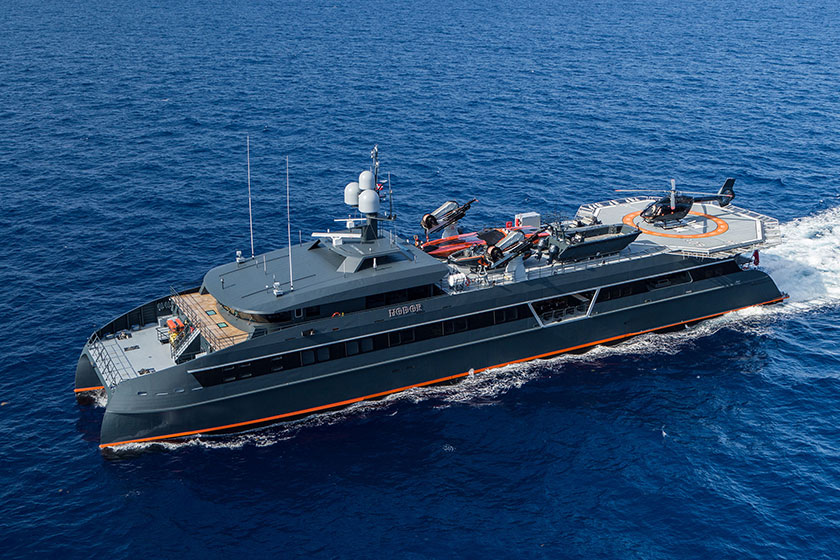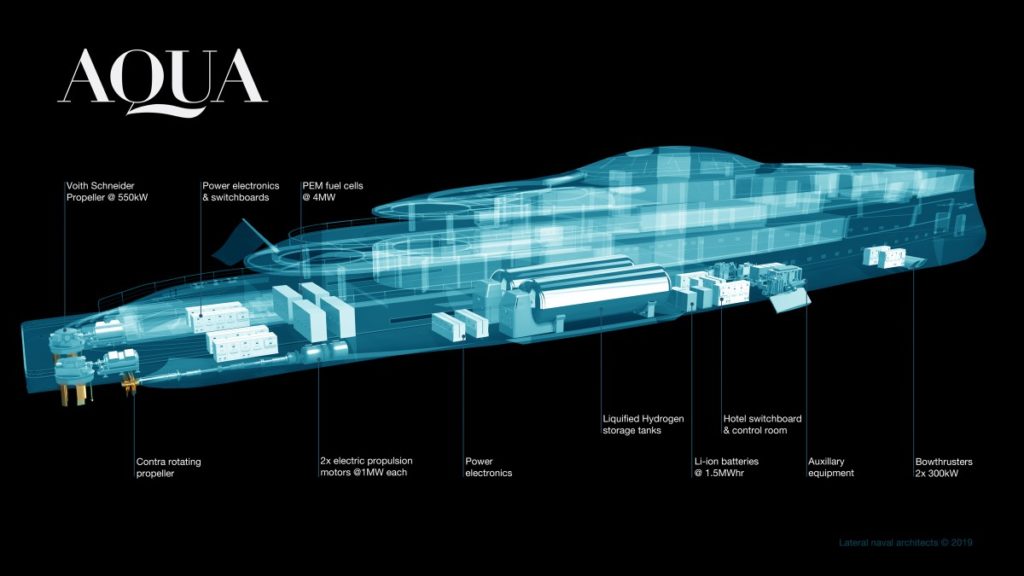Hydrogen: minimising impact does not necessarily mean minimising space

A major drawback of hydrogen-fuelled yachts is the amount of utilisable space taken up by the infrastructure required for hydrogen-electric propulsion, according to Simon Brealey of Lateral Naval Architects.
Lateral recently released its propulsion concept for the future of yachting, Aqua, featuring two 28t capacity liquid hydrogen tanks powering proton-exchange memory fuel cells. As with all hydrogen-powered engines the system’s only biproduct is water.
Also, Aqua’s comparably high length-to-displacement ratio – 112 metres to 3,530 tonnes – allows for a 30% reduction in water resistance thereby saving energy for use elsewhere on board. However, when compared with traditional, diesel-electric propulsion systems, hydrogen-electric requires significantly more room in the hull. The two storage tanks of cryogenically cooled liquid hydrogen (at -253 degrees C) and a 1.5 MW battery pack, which acts as a constant electrical source, take up the majority of the lower-fifth deck space. That is space that would largely be free for other uses in diesel or diesel-electric hybrid propelled yachts.
As yachts have continued to increase in size, so has their energy consumption. Mathieu Salomon of C & N Marinas made this comparison: “A typical UK household uses 0.5 kwh and a superyacht uses about 500kwh.” Meaning a superyacht uses about 1000 times the power of an average UK household.
In his presentation at Superyacht Investor London 2020 last week, Brealey noted that a key driver behind the push towards sustainability was the high-profile individuals who commission and own the superyachts. He said that the image of superyachting as a polluter was a barrier to encouraging the next generation into the pastime. But if sustainable superyachting is to become a necessity, whether by cultural obligation or because of legislation introduced by the International Maritime Organization, owners will need to adjust to having less utilisable space aboard.
Enter stage then, the growing market for shadow and support vessels. Incat Crowther’s technical manager, Dan Mace, told the conference, “We have observed a growing market for shadow vessels recently. As yachts have increased in size significantly over the past decade or so, the concept of detaching the roles has become quite attractive.”
The Australian catamaran designer released its 66-metre support vessel, Hodor, last year winning Work Boat World’s best superyacht-support vessel accolade of the year 2019. It could answer many of the questions relating to the desire for extra space aboard a super yacht according to Mace. “Hodor has a huge capability and capacity for her size, combined with low running costs, the platform represents excellent value to perform the job at hand.”
“The platform’s high speed, lower engine-power requirement and deck capacity are key advantages driving the hull selection. Hodor accommodates an EC145 Helicopter, five tenders from 7 metres to 17 metres, four jet skis, four quad bikes, an ROV [remotely operated underwater vehicle] and an Aurora 5 submarine. The Shadow Cat concept [an expanded version of Hodor] is available with additional features, which allow options for larger helicopters, full-sized hangar, additional cabins, lounge areas and recreational spaces,” said Mace.

A cruising range of 5,500 nautical miles at 14 knots means Hodor, or a similarly sized support vessel, is capable of accompanying a hydrogen-powered superyacht like Aqua which purports to have a range of 3,750 nautical miles.
Industry opinion appears to be that the trend of environmentally friendly yachts is set to continue to grow. Jamie Edmiston, chief executive of Edmiston, told Superyacht Investor’s conference: “Increasingly people are prepared to put their money where their thoughts and minds are. Some people are prepared to put a lot of money into a project to become more environmentally friendly.” And according to BNP Paribas’ Oliver Blanchet the industry needs to move fast in the right direction when it comes to climate action, “How we respond to this challenge will be key to the success and the longevity of this industry.”
Despite reports in The Sunday Telegraph, Microsoft co-founder, Bill Gates, has not just commissioned a hydrogen-powered superyacht based on Aqua, for a reported $500m. Sinot recently released a statement refuting claims that software tycoon has purchased the blueprints for their design, contrary to popular belief in the media.

Aqua’s hydrogen-electric propulsion
- Two vacuum-isolated tanks designed to keep liquid hydrogen stable at -253 degrees C (-423.4° F) sit behind strengthened glass for safety
- Hydrogen is converted to electrical energy via proton-exchange-memory (PEM) fuel cells
- Each tank can split off energy at up to 4MW and both power a 1MW electric propulsion motor and two 300KW bow thrusters
- A 1.5 MW battery pack acts as a buffer for constant electrical supply and is refuelled by the PEM fuel cells as necessary
- Aqua will cruise at 10-12 knots for 3,750 miles
- Aqua will have a top speed of 17 knots.
Subscribe to our free newsletter
For more opinions from Superyacht Investor, subscribe to our email newsletter.

